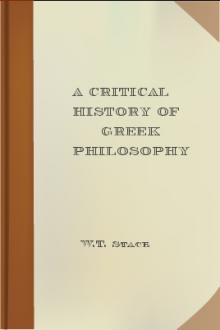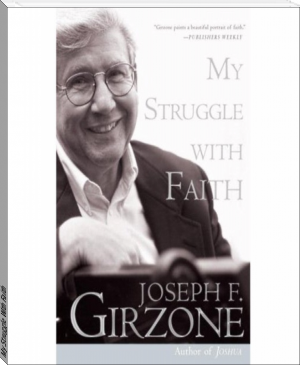A History of Indian Philosophy, Vol. 1 by Surendranath Dasgupta (desktop ebook reader txt) 📕

- Author: Surendranath Dasgupta
- Performer: -
Book online «A History of Indian Philosophy, Vol. 1 by Surendranath Dasgupta (desktop ebook reader txt) 📕». Author Surendranath Dasgupta
We thus see that the earliest beginnings of most systems of Hindu thought can be traced to some time between 600 B.C. to 100 or 200 B.C. It is extremely difficult to say anything about the relative priority of the systems with any degree of certainty. Some conjectural attempts have been made in this work with regard to some of the systems, but how far they are correct, it will be for our readers to judge. Moreover during the earliest manifestation of a system some crude outlines only are traceable. As time went on the systems of thought began to develop side by side. Most of them were taught from the time in which they were first conceived to about the seventeenth century A.D. in an unbroken chain of teachers and pupils. Even now each system of Hindu thought has its own adherents, though few people now
9
care to write any new works upon them. In the history of the growth of any system of Hindu thought we find that as time went on, and as new problems were suggested, each system tried to answer them consistently with its own doctrines. The order in which we have taken the philosophical systems could not be strictly a chronological one. Thus though it is possible that the earliest speculations of some form of Sâ@mkhya, Yoga, and Mîmâ@msâ were prior to Buddhism yet they have been treated after Buddhism and Jainism, because the elaborate works of these systems which we now possess are later than Buddhism. In my opinion the Vais'e@sika system is also probably pre-Buddhistic, but it has been treated later, partly on account of its association with Nyâya, and partly on account of the fact that all its commentaries are of a much later date. It seems to me almost certain that enormous quantities of old philosophical literature have been lost, which if found could have been of use to us in showing the stages of the early growth of the systems and their mutual relations. But as they are not available we have to be satisfied with what remains. The original sources from which I have drawn my materials have all been indicated in the brief accounts of the literature of each system which I have put in before beginning the study of any particular system of thought.
In my interpretations I have always tried to follow the original sources as accurately as I could. This has sometimes led to old and unfamiliar modes of expression, but this course seemed to me to be preferable to the adoption of European modes of thought for the expression of Indian ideas. But even in spite of this striking similarities to many of the modern philosophical doctrines and ideas will doubtless be noticed. This only proves that the human mind follows more or less the same modes of rational thought. I have never tried to compare any phase of Indian thought with European, for this is beyond the scope of my present attempt, but if I may be allowed to express my own conviction, I might say that many of the philosophical doctrines of European philosophy are essentially the same as those found in Indian philosophy. The main difference is often the difference of the point of view from which the same problems appeared in such a variety of forms in the two countries. My own view with regard to the net value of Indian philosophical development will be expressed in the concluding chapter of the second volume of the present work.
10
CHAPTER II THE VEDAS, BRÂHMANAS AND THEIR PHILOSOPHYThe Vedas and their antiquity.
The sacred books of India, the Vedas, are generally believed to be the earliest literary record of the Indo-European race. It is indeed difficult to say when the earliest portions of these compositions came into existence. Many shrewd guesses have been offered, but none of them can be proved to be incontestably true. Max Müller supposed the date to be 1200 B.C., Haug 2400 B.C. and Bâl Ga@ngâdhar Tilak 4000 B.C. The ancient Hindus seldom kept any historical record of their literary, religious or political achievements. The Vedas were handed down from mouth to mouth from a period of unknown antiquity; and the Hindus generally believed that they were never composed by men. It was therefore generally supposed that either they were taught by God to the sages, or that they were of themselves revealed to the sages who were the "seers" (mantradra@s@tâ) of the hymns. Thus we find that when some time had elapsed after the composition of the Vedas, people had come to look upon them not only as very old, but so old that they had, theoretically at least, no beginning in time, though they were believed to have been revealed at some unknown remote period at the beginning of each creation.
The place of the Vedas in the Hindu mind.
When the Vedas were composed, there was probably no system of writing prevalent in India. But such was the scrupulous zeal of the Brahmins, who got the whole Vedic literature by heart by hearing it from their preceptors, that it has been transmitted most faithfully to us through the course of the last 3000 years or more with little or no interpolations at all. The religious history of India had suffered considerable changes in the latter periods, since the time of the Vedic civilization, but such was the reverence paid to the Vedas that they had ever remained as the highest religious authority for all sections of the Hindus at all times. Even at this day all the obligatory duties of the Hindus at birth, marriage, death, etc., are performed according to the old
11
Vedic ritual. The prayers that a Brahmin now says three times a day are the same selections of Vedic verses as were used as prayer verses two or three thousand years ago. A little insight into the life of an ordinary Hindu of the present day will show that the system of image-worship is one that has been grafted upon his life, the regular obligatory duties of which are ordered according to the old Vedic rites. Thus an orthodox Brahmin can dispense with image-worship if he likes, but not so with his daily Vedic prayers or other obligatory ceremonies. Even at this day there are persons who bestow immense sums of money for the performance and teaching of Vedic sacrifices and rituals. Most of the Sanskrit literatures that flourished after the Vedas base upon them their own validity, and appeal to them as authority. Systems of Hindu philosophy not only own their allegiance to the Vedas, but the adherents of each one of them would often quarrel with others and maintain its superiority by trying to prove that it and it alone was the faithful follower of the Vedas and represented correctly their views. The laws which regulate the social, legal, domestic and religious customs and rites of the Hindus even to the present day are said to be but mere systematized memories of old Vedic teachings, and are held to be obligatory on their authority. Even under British administration, in the inheritance of property, adoption, and in such other legal transactions, Hindu Law is followed, and this claims to draw its authority from the Vedas. To enter into details is unnecessary. But suffice it to say that the Vedas, far from being regarded as a dead literature of the past, are still looked upon as the origin and source of almost all literatures except purely secular poetry and drama. Thus in short we may say that in spite of the many changes that time has wrought, the orthodox Hindu life may still be regarded in the main as an adumbration of the Vedic life, which had never ceased to shed its light all through the past.
Classification of the Vedic literature.
A beginner who is introduced for the first time to the study of later Sanskrit literature is likely to appear somewhat confused when he meets with authoritative texts of diverse purport and subjects having the same generic name "Veda" or "S'ruti" (from s'ru to hear); for Veda in its wider sense is not the name of any
12
particular book, but of the literature of a particular epoch extending over a long period, say two thousand years or so. As this literature represents the total achievements of the Indian people in different directions for such a long period, it must of necessity be of a diversified character. If we roughly classify this huge literature from the points of view of age, language, and subject matter, we can point out four different types, namely the Sa@mhitâ or collection of verses (sam together, hita put), Brâhma@nas, Âra@nyakas ("forest treatises") and the Upani@sads. All these literatures, both prose and verse, were looked upon as so holy that in early times it was thought almost a sacrilege to write them; they were therefore learnt by heart by the Brahmins from the mouth of their preceptors and were hence called s'ruti (literally anything heard)[Footnote ref 1].
The Sa@mhitâs.
There are four collections or Sa@mhitâs, namely @Rg-Veda, Sâma-Veda, Yajur-Veda and Atharva-Veda. Of these the @Rg-Veda is probably the earliest. The Sâma-Veda has practically no independent value, for it consists of stanzas taken (excepting only 75) entirely from the @Rg-Veda, which were meant to be sung to certain fixed melodies, and may thus be called the book of chants. The Yajur-Veda however contains in addition to the verses taken from the @Rg-Veda many original prose formulas. The arrangement of the verses of the Sâma-Veda is solely with reference to their place and use in the Soma sacrifice; the contents of the Yajur-Veda are arranged in the order in which the verses were actually employed in the various religious sacrifices. It is therefore called the Veda of Yajus—sacrificial prayers. These may be contrasted with the arrangement in the @Rg-Veda in this, that there the verses are generally arranged in accordance with the gods who are adored in them. Thus, for example, first we get all the poems addressed to Agni or the Fire-god, then all those to the god Indra and so on. The fourth collection, the Atharva-Veda, probably attained its present form considerably later than the @Rg-Veda. In spirit, however, as Professor Macdonell says, "It is not only entirely different from the Rigveda but represents a much more primitive stage of thought. While the Rigveda deals almost exclusively with the higher gods as conceived by a
_____________________________________________________________________
[Footnote 1: Pâ@nini, III. iii. 94.]
13
comparatively advanced and refined sacerdotal class, the Atharva-Veda is, in the main a book of spells and incantations appealing to the demon world, and teems with notions about witchcraft current among the lower grades of the population, and derived from an immemorial antiquity. These two, thus complementary to each other in contents are obviously the most important of the four Vedas [Footnote ref 1]."
The Brâhma@nas. [Footnote ref 2]
After the Sa@mhitâs there grew up the theological treatises called the Brâhma@nas, which were of a distinctly different literary type. They are written in prose, and explain the sacred significance of the different rituals to those who are not already familiar with them. "They reflect," says Professor Macdonell, "the spirit of an age in which all intellectual activity is concentrated on the sacrifice, describing its ceremonies, discussing its value, speculating on its origin and significance." These works are full of dogmatic assertions, fanciful symbolism and speculations of an unbounded imagination in the field of sacrificial details. The sacrificial ceremonials were probably never so elaborate at the time when the early hymns were composed. But when the collections of hymns were being handed down from generation to generation the ceremonials became more and more complicated. Thus there came about the necessity of the distribution of the different sacrificial functions among several distinct classes of priests. We may assume that this was a period when the caste system was





Comments (0)